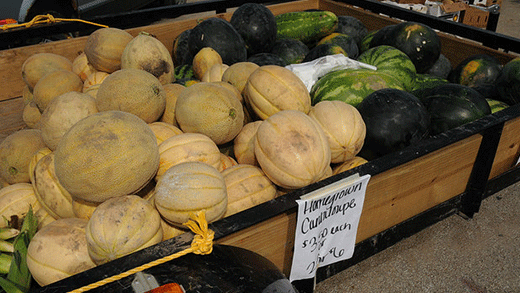
Knowing what to look for will help you pick a delicious melon at the fruit stand.
Thump Test? There’s a better way to pick a ripe watermelon
The color of the ground spot is key to finding a tasty melon
July 15, 2020
MANHATTAN, Kan. – It’s common in most grocery stores this time of year to find shoppers who swear by the theory that a good “thump” on the outside of a watermelon is a sure way to pick a winner.
Ward Upham, a horticulture expert at Kansas State University, says there’s a more scientific way to take home a great-tasting watermelon.
“Ripe watermelons normally develop a yellow color on the ‘ground spot’ when ripe,” Upham said. “This is the area that contacts the ground.”
Upham said the depth of the yellow varies depending on the type of melon. “Most striped melons should have a bright, buttery yellow color, and dark green watermelons a deep yellow color. Light green melons develop a light yellow coloration. As a general rule, if the ground spot has a cream-like, off-white color, the watermelon is not ripe.”
When picking watermelons in a field, Upham advises looking for the tendril that attaches at the same point of the melon to dry and turn brown. “On some varieties, this will need to be completely dried before the watermelon is ripe,” he said. “On others, it will only need to be in the process of turning brown.”
A ripe watermelon typically will develop a roughness on its surface (sometimes called sugar bumps) near the base of the fruit. In the field, that’s when growers should harvest the fruit.
Many other melons also are in season right now.
“Muskmelons are one of those crops that tell you when they are ready to be picked,” Upham said. “As a melon ripens, a layer of cells around the stem softens so the melon detaches easily from the vine. This is called ‘slipping’ and will leave a dish-shaped scar where the stem attaches.”
When harvesting muskmelons, he notes, put a little pressure where the vine attaches to the fruit. “If it’s ripe, the melon will release, or ‘slip,’” he said.
Ripe melons usually will have the dish-shaped scar where the stem was attached. Upham added they will also have a pleasant, musky aroma if they’ve been held at room temperature for a period of time, rather than refrigerated.
“Honeydew melons are the most difficult to tell when they are ripe because they do not ‘slip’ like muskmelons,” Upham said, noting that the Earlidew variety is an exception. “Ripe honeydew melons become soft on the flower end of the fruit, which is the end opposite where the stem attaches. Also, honeydews should change to a light or yellowish color when ripe, but this varies with variety.”
Upham and his colleagues in K-State’s Department of Horticulture and Natural Resources produce a weekly Horticulture Newsletter with tips for maintaining gardens and home landscapes. The newsletter is available to view online or can be delivered by email each week.
Interested persons can also send their garden- and yard-related questions to Upham at wupham@ksu.edu, or contact your local K-State Research and Extension office.
